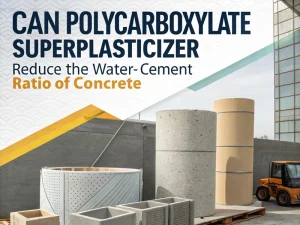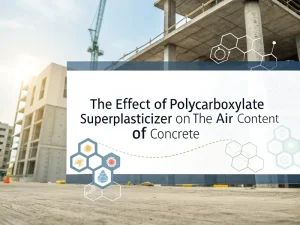
Can Polycarboxylate Superplasticizer Reduce The Water Cement Ratio Of Concrete?
Blog Can polycarboxylate
Blog

The current mainstream superplasticizer is a polycarboxylate superplasticizer.
The primary function of Polycarboxylate Superplasticizer is to reduce the amount of water required during the concrete mixing process while improving the fluidity, workability, and durability of the concrete.
1. Reduce water usage
It can significantly reduce the water-cement ratio of concrete, thereby reducing water consumption. This not only helps to save water resources but also improves the durability of concrete.
By effectively dispersing the cement particles, they create a more fluid mixture without the need for excessive water. This reduction in water-cement ratio is crucial as it leads to an increase in the compressive strength of the concrete.
A lower water-cement ratio means a denser and more durable concrete structure. For instance, in the production of precast concrete elements, the use of superplasticizers allows for a significant reduction in water content, resulting in stronger and more reliable products.
2.Improve the workability of concrete
After adding this, the flowability and plasticity of concrete are significantly improved, making it easier to construct and operate. This is very advantageous for the construction of complex building structures and large-scale infrastructure projects.
3.Improve concrete strength
It can effectively disperse cement particles, directly improving the compactness of concrete and thus enhancing its strength. At the same time, it can also reduce pores and cracks in concrete, further improving strength and durability.
As the water cement ratio decreases, the hydration process of cement is optimized, resulting in a denser and stronger structure. This is particularly important in applications that require high-strength concrete, such as bridge decks, industrial floors, and structural components of large buildings.
The increased strength also enables concrete to better withstand various loads and environmental stresses during its service life.
4.Improve the durability of concrete
Due to its ability to reduce the water-cement ratio and porosity of concrete, it can improve the carbonation resistance, impermeability, frost resistance, and chemical resistance of concrete and prolong the overall service life of concrete structures.
The reduced water-cement ratio helps to minimize the porosity of the concrete, making it more resistant to the ingress of harmful substances such as chloride ions, sulfate ions, and carbon dioxide. This resistance to chemical attack and corrosion is vital for structures exposed to harsh environments, like marine structures or those in industrial areas with chemical pollutants.
Additionally, the improved microstructure and reduced permeability also enhance the concrete’s resistance to freeze-thaw cycles, preventing cracking and deterioration caused by repeated freezing and thawing of water within the pores.
5.Reduce concrete shrinkage and deformation
Polycarboxylate superplasticizers actually replaces a part of water, reduces internal bubbles and small voids, and improves the compactness of concrete, thereby reducing concrete deformation and, cracking and small deformations.
6.Reduce cement usage
It has strong applicability with materials such as cement, reducing the water and cement consumption of concrete, thereby lowering the cost of concrete.
7.Good compatibility with cement
It can fully integrate with cement particles to enhance the strength and durability of concrete.
Superplasticizers are highly compatible with supplementary cementitious materials (SCMs) such as fly ash, slag, and silica fume. These SCMs are often used to improve the performance of concrete in terms of strength, durability, and sustainability.
The superplasticizer helps to disperse both the cement particles and the SCM particles evenly, ensuring that they work together synergistically. This compatibility allows for the development of more advanced and sustainable concrete mixtures, meeting the demands of modern construction for both performance and environmental friendliness.

Blog Can polycarboxylate

Blog The effect of polyca